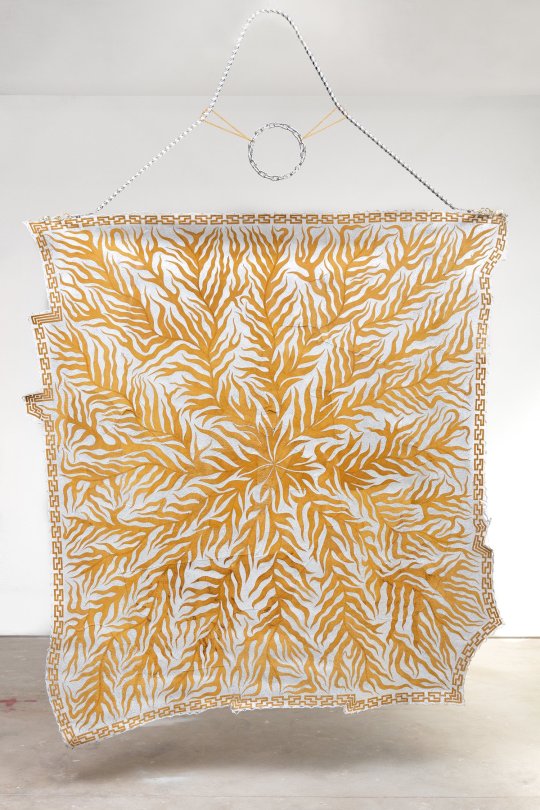#material history
Text
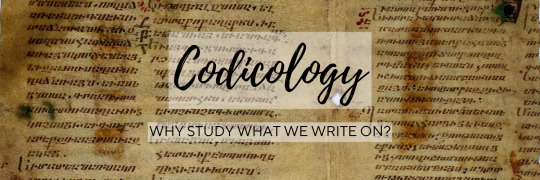
“The manuscript book isn’t only the necessary medium for the trasmission of ancient and medieval culture: it’s also a complex and dynamic object, which reflects, in its appearance and physical structure, the cultural, economical, social and political changes through the centuries.” - Marilena Maniaci.
Throughout history, humankind has always felt the need to communicate, and to fulfil that need has used a variety of recipients for their writing — organic, inorganic, of plant or animal origin… Before, and alongside, the well-known triptych of papyrus-parchment-paper were and are clay, shards of pottery, metals, fabrics, leaves, wood, bones…


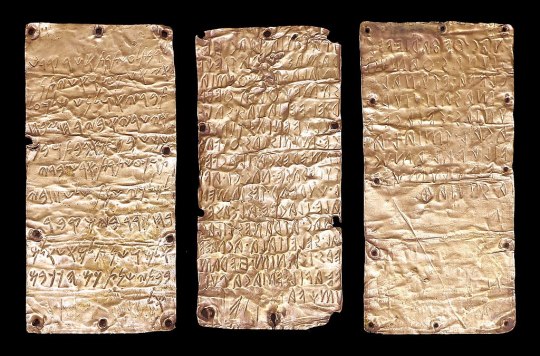
Any writing, in its materiality, is a two-faced coin. One face is that which can be easily (or not) seen, such as the text and the images. The other face is all that is not seen, be it inside the writing, such as the material aspects, the structure, the techniques, or outside the writing, such as the culture or socio-economic situation.
While philology and palaeography study the text and images are the interest of art historians, that hidden other face is the subject of research of codicology, particularly in its acceptation of archaeology of manuscripts. Codicology is a relatively recent branch of studies, which originates as an ancillary science to philology and palaeography and as such still lacks a unified method or mission, but in the aforementioned meaning of the term and for what concerns us, it can be defined as the study of the history of codices (sing. codex).
Codicology, then, studies the codex in everything that isn’t text and writing, and partially images (although all of these things give contextual information, and are taken into consideration). But what, exactly, is a codex?
A codex isn’t a book, it’s not even a scroll - at least, not necessarily. As defined by Marilena Maniaci a codex is “a container of information, mostly textual, but also visual and musical, in which the dimension of immaterial ideas interacts, in different and complex ways, with the materiality of the object.” More simply, a codex is any object consisting of a material which has been written on or which was meant to be written on and which has been bound or could have been bound.
A scroll is a codex, a book is a codex, but also ostraka (pottery shards) which have been tied together through holes, or a single and quite big piece of vellum which has been folded.
The three following images are all codices, as different as they may seem!


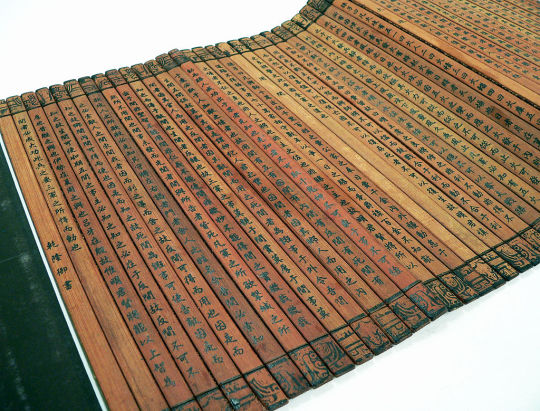
Codicology studies the materials a codex is composed of, the way it was produced, used, re-used, its history throughout the years, in whose hands it ended up and how its “adventures” influenced its physicality. These informations, seemingly of secondary importance, can give us interesting insights on the times the codex “lived” through.
#history chirp#history#material history#manuscript#manuscript history#medieval manuscripts#papyrus#parchment#paper#writing table#codicology#codex#medieval codex#book of hours#writing history
11 notes
·
View notes
Text
I’ve been down a rabbit hole wondering about medieval jewelry (and if I can reproduce it despite having no metalworking skills, to which the answer is mostly no) lately & I figured I would share the fruits of my museum collection searches for other medievalists/hobbyists/reenactors/nerds.
Jewelry of the 13th Century Anglo/Francosphere

TL;DR
Metals: 🟨 gold(tone)
Stones: mostly 🔵 cabochon, rarely 💠 simple cut, some carved 🗿 intaglio or cameo
Stone Colors: warm blues, emerald green, purples, burgundies, reds
Materials: enamel, 💎 gemstones (garnet, Ceylon sapphire, ruby/spinel, emerald) or glass paste imitations, ⚪ semi-precious stones (pearl, lapis, jasper, carnelian, coral, turquoise, porphyry)
Settings: bezel (oval and rectangular); ⚜️ intricate metalwork; more visible and textured metal than modern jewelry; more mixtures of stones and colors than modern tastes
Motifs: ◯ round, ✤ quatrefoil, ✙ cross, ✸ star (even numbers of points), ♣ trefoil, ❦ floral, 🐉 animals, 𝕬 inscription
Formats: brooches, ornamented clothing, rings, pendants, circlets, cuffs (rare)
A detailed look:
Some forms of jewelry that were very popular in the Roman Empire and are again today were just not the thing in the middle European Middle Ages. (Earrings, for example, seem to have barely existed. This is partially at least because ears were covered--by coifs and caps, hair, and (for women) braids or the chin strap and fillet/wimple/gorget.) In fact, a lot of the places we would put jewelry against our skin today were covered.
This left some other options:
Jewelry on Clothing
Medallions
Okay, these aren’t jewelry, strictly speaking, but they’re metalwork ornaments associated with a person.
Enamel Mitre Medallions


OA 3437 and OA 3438
Before 1291, Ile de France
Louvre, Paris
photos (c) Musée du Louvre / Stéphane Maréchalle 2015
Cloisonné and plique enamel over gold and copper, with decorative motifs of trefoils, quatrefoil, and stars in a palette of dark blue and green with accents that may once have been ruby red.
Appliqué Medallion
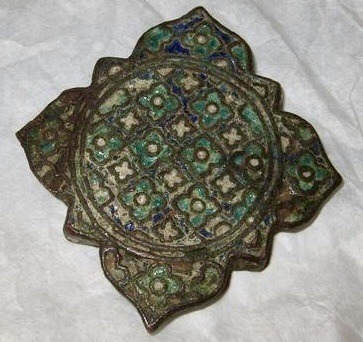
# MRR 256
13th c., Limoge
Louvre, Paris
photo (c) Musée du Louvre 2014
Gilded copper (though most gold is worn off) with quatrefoil champlevé enamel in emerald green, lapis blue, and white or off-white.
Brooches
Perhaps the most prevalent medieval jewelry item in the Anglo & French regions. These were worn at the shoulder for men and breast for women, often anchoring a cloak, or to close the collar. As the ornate fermail and double-ring brooch suggest, these ran the gamut from practical to incredibly decorative and ornate.
Garnet & Silver Gilt Animal Ring Brooch; Green and Blue Glass and Gilt Ring Brooch


Left, # 2003,0703.1
13th century; found in Suffolk, England
British Museum, London
photo (c) The Trustees of the British Museum
Right, # M.28-1929
13th c., England
V&A, London
photo © Victoria and Albert Museum, London
Cabochon garnets or carbuncles in the gilded silver brooch (L), perhaps once paired with smaller stones in the eyes of metalwork animals that bite the pin bracket. The right brooch, also silver gilt, sports two glass paste emerald and sapphire "gems" in cabochon. It was probably a lover's token; it reads (in Lombardic-lettered French) IOSV ICI ATI VCI or "jo su[i] ici a t[o]i v[o]ici" which I might translate as "I am here with/belonging to you, look!"
Ruby & Sapphire Ring Brooch; Sapphire, Garnet, and Pearl Fermail
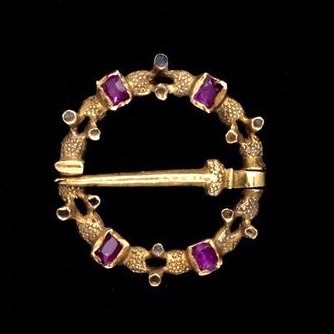
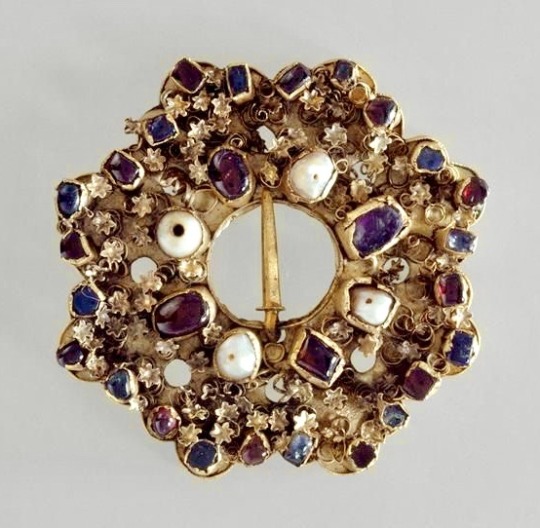
Left, # 6808-1860
1275-1300, England
V&A, London
photo © Victoria and Albert Museum, London
Right, # OA6287
1250-1300, France
Louvre, Paris
photo (c) Musée du Louvre
Blogs often claim that stones were only polished en cabochon until the 16th century, and that medieval jewelers couldn't cut gemstones. But this 13th-century gold ring brooch (left) pairs table-cut purple rubies with collet-set cabochon sapphires, and may evidence early medieval gem-cutting or reuse of Roman cut stones. The silver gilt fermail, right, includes pearl beads, garnets and sapphires both cut and cabbed, and one glass paste cabochon. Both are intricately textured, with punchwork (L) and floral metalwork, probably cast and then attached (R).
Double Ring Brooch with Sapphire and Glass "Emeralds"
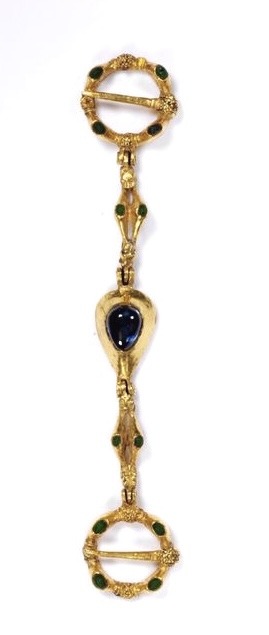
# M.26-1993
13th c., England
V&A, London
photo © Victoria and Albert Museum, London
This gold double brooch is so small they think it was for a woman or child. Central sapphire cab is flanked by glass paste "emeralds" in bezel settings and metalwork featuring two animal heads.
Jewelry on the Body
Rings
Many are probably familiar with the signet ring, used for pressing into sealing wax, which could be intaglio-carved gemstone or metals. There were also a number of decorative and/or talismanic gemstone rings.


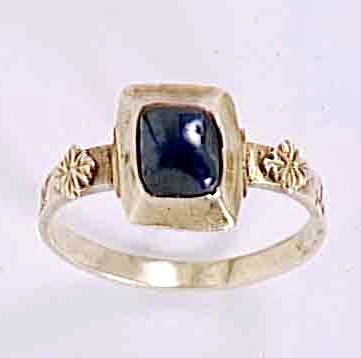
LtR:
#M.7-1929 | #M.180-1975 | #OA 11265
1250-1300, England | 1250-1300, Engl/France | 13th c., Engl/France
V&A, London | V&A, London | Louvre, France
photos L&C © Victoria and Albert Museum, London | R (c) Musée du Louvre
Sapphire in gold is the name of the game when it comes to rings in the thirteenth century; even the purple stones on the left are purple sapphires. (Sapphires were said to aid chastity, purity, and the effectiveness of prayer.) For larger stones, the bezel often has claws added (L); the central ring is an example of a full claw setting that modern viewers might find surprisingly tall. Naturalistic flourishes are added (C & R); these might be pre-cast then attached to the base (R).
Pendants
We equate pendants with necklaces, but their medieval applications also included wear as badges, from headpieces, and on horse decorations.


Left, bloodstone jasper cameo in silver setting
# MRR 218
1100-1300, France?
Louvre, Paris
photo (c) Musée du Louvre / Jean Blot 1984
Right, champlevé enamel, gilt copper, and paste "emerald" (harness) pendant
# 1976.169
13th c., France
Cleveland Museum of Art, Cleveland
photo CC0 Open Access
Statue Jewelry
From here, we get into the really ridiculous stuff; the previous categories could be relatively everyday (as much as ornamentation reserved exclusively for the wealthy can be an everyday thing) but the following examples are astonishing displays not necessarily for wear.
"La Couronne" de Vierge et l'Enfant d'ivoire de la Sainte-Chapelle

# OA 57 B
1250-1300, France
Louvre, Paris
photo (c) Musée de Louvre
This was not even a crown for a person, but rather for a painted ivory statue of the Virgin Mary, holding her infant son. (Though circlets, even set with stones, were sometimes worn as part of women's head dress.) It's incredibly ornate gold, set with pearls, garnets and rubies, sapphires, and turquoise (?) en cabochon.
Anneau de Saint-Denis




# MS 85 BIS
1200-1215, France
Louvre, Paris
photos (c) Musée du Louvre / Daniel Arnaudet 1990
This astonishing piece, which is ring-sized but now displayed as a cuff on an ivory hand, is made of gold and displays every possible gemstone appearance characteristic of the period. The front piece has a central sapphire and is surrounded by quartz with red backing (mimicking ruby/garnet), amethysts, pearls, and sapphires, some set on yellow backing (mimicking turquoise?). Most are en cabochon on this face, but two are faceted and two intaglio. Were this not enough, the three other 'faces' of the ring are set with gems as well, two cameos (probably sapphire and garnet?) and one amethyst intaglio set in ornate gold filigree.
#medieval#jewelry making#lapidary#history of fashion#historical jewelry#1200s#reenactment#England#France#enamel jewelry#ring brooch#fermail#intaglio#cameo#gemstones#infodumping#now time to go to the bead store#material history#you would think this is for my research or academically relevant but it's not I just couldn't stop looking at shiny things help#photos not mine#photos for educational purposes and not for commercial reproduction#louvre#v&a museum#british museum#cleveland museum of art
33 notes
·
View notes
Text
im too emotional to be reading papers about material history and how all objects have meaning, how they reflect the culture that used it, how a person may find a certain object so important that others would have overlooked and honestly yeah...the memories that we form with our everyday objects, the cup that your partner always love to drink their morning coffee out of, the dressing gown that your brother always wears, the shoddy TV that you and your loved ones gather around to watch your favourite show every day...yeah these things are merely just things to the outside eye but they encapsulate the entire experience of being a human, don't they?
0 notes
Text
Ever see a depiction of St. George and the Dragon? It's pretty fair to say if you've seen one, you've seen them all: Georgie on a horse stabbing a flailing dragon creature, princess piously kneeling in the background, vague landscape alluding to the homeland of the artist's patron.
The most varied part is the dragons. No one had a real definition for the thing, it seemed. For your pleasure and entertainment, I have ranked some medieval depictions based on how impressive George's feat seems once you see the dragon.
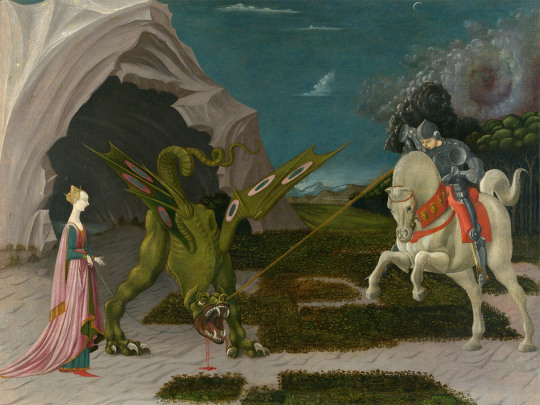
Paolo Uccello, 1456
This is a terrifying beast. The hell is that. Uccello was one of the first experimenters with perspective, so the thing also looks surreal, like it's taking place on Mars, or a Windows 95 screensaver. I would not want to fight that, I would not want to be tied to that. (Sometimes the princess is tied to the dragon for some reason.) 10/10
Horse thoughts: Maybe if I look at the ground it will be gone when I look up
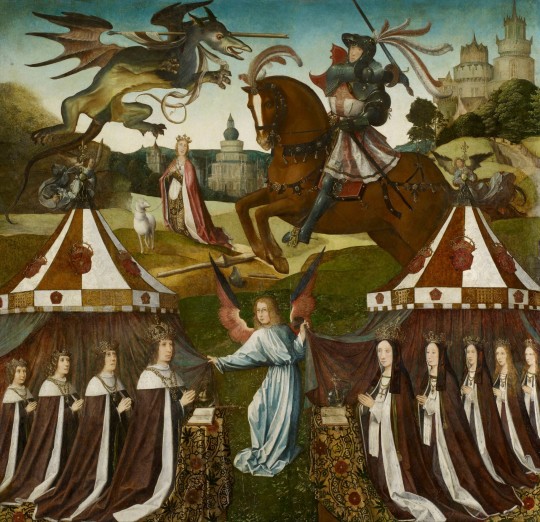
Unknown artist, c. 1505
This is a rare change of form for the dragon; it's the only one I've seen actually flying (or at least falling with style). It doesn't look particularly deterred by the spear through its throat, either. Also, George looks appropriately nervous. On the other hand, it hasn't got teeth, it seems to be fuzzy rather than having scaly armor, and George is bolstered by his army of Henry VII and his children, most of whom definitely didn't actually die in infancy. Still, wouldn't want to fight it, wouldn't want my pet sheep near it. (Sometimes the princess has a pet sheep for some reason.) 9/10
Horse thoughts: I am so glad I wore my mightiest feather helmet for this
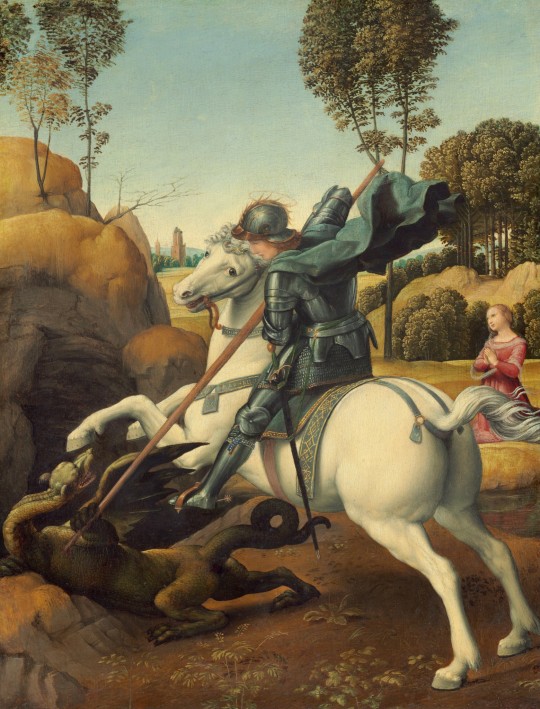
Raphael, 1505
We are coming to Dragons With Problems. This guy looks about comparable in size to George, and does have wings, but doesn't seem to be using these things to his advantage (and has he only got one wing?) And how does he deal with the neck? He does have a comically small head, but holding it up with such a twisty neck seems complicated at best. But most egregiously, he is doing the shitty superheroine pose where he is somehow simultaneously showcasing his chest and his butt, with its unnecessarily defined butthole (more on this later) (regrettably). 8/10 bc it's Raphael
Horse thoughts: AM I THE BESTEST BOI? AM I DOING SUCH A GOOD JOB? WE R DRAGON SLAYING BUDDIEZ

The Beauchamp Hours, c. 1401
We had a spirited debate about this one at work. Again, the dragon has gotten smaller, and this one hasn't got even one wing. He's basically a crocodile. So the debate became: would you want to fight a crocodile if you had a horse and a pointy stick? Would the horse trample the animal, who can't get on its hind legs, or freak out and throw its rider? Would the pointy stick be enough to pierce the croc's thick hide? In this case, George seems to be controlling his horse and putting his pointy stick in the dragon's weak spot, so we can be impressed by his skill and strategy. However, his hat is dumb. 7/10
Horse thoughts: Dehhhh

Book of Hours, c. 1480
Here we have the same kind of croco-dragon, but George's focus on his strategy has gone out the window. He's flailing around, not even looking at his target, he's about to lose his pointy stick, he hasn't got a hand on the reins, and his sword seems to only be poking the invisible dragon over his shoulder. All he's got going for him is that his hat is slightly less dumb. 6/10
Horse thoughts: Yay, new friend! Come play with me, new fr- what is happening
Final dragons put behind this Read More for your safety:
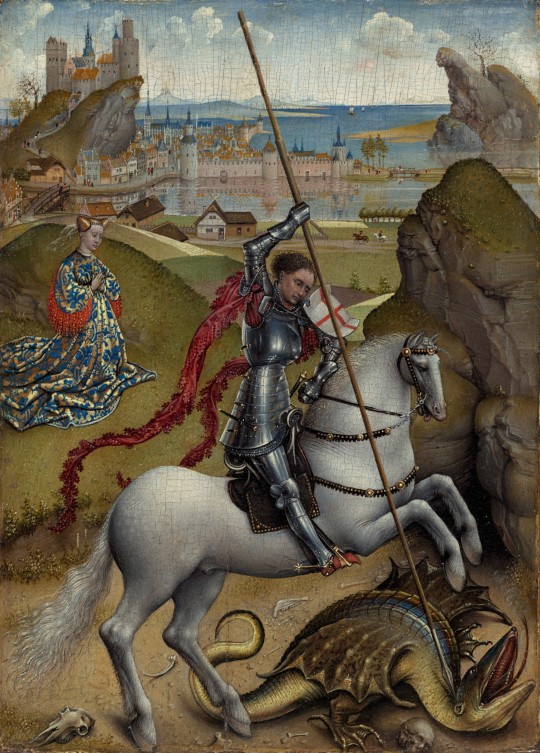
Rogier van der Weyden, c. 1432
I'm thinking this guy is at least semi-aquatic. Webbed feet, wings that seem more like fins, bipedal but top-heavy, jaws that seem more for scooping than biting. Maybe she's crawled up here from the nearby body of water to lay her eggs, and this is all a big misunderstanding. Moreover, George's dagged sleeves seem entirely impractical for the situation. 5/10
Horse thoughts: i got my hed stuk in a jar and now it is this way forever

Unknown artist, c. 15th century
I hate this. I hate everything about it. Why has it got human eyes and teeth. Why is its nose melting. Why has it got a dick on its face and balls under its chin. The fin/wings are back but they look even more useless. Also, George is shifty as hell, schlumped over in his saddle with his bowler hat thing over his eyes. The baby dragon at the bottom eating some hapless would-be rescuer is kind of metal. 4/10 at least the thing is gonna die
Horse thoughts: I Have Smoked So Much Crack

Book of Hours, c. 1450
Remember what I said about the buttholes? First, sorry. Second, yeah, we're back to that. I'll admit this one is less about the danger from the dragon itself than the very specific choices the artist has made. They didn't need to do that. It's a lizard. They don't even have. And it's like they had an orifice budget and they skipped an exit wound for the spear to focus. Elsewhere. It's so detailed. And George had an even dumber hat. 2/10 take it away
Horse thoughts: I Have Smoked So Much Weed
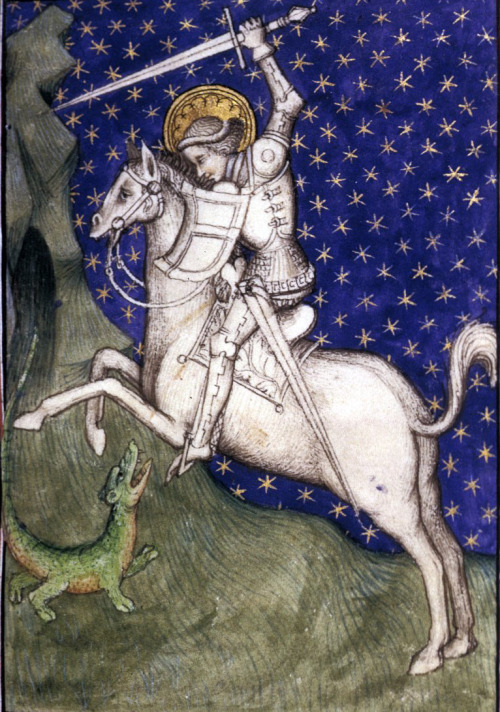
Book of Hours, c. 1415
This is just bullying. There isn't even a princess. That is clearly an infant. Look at that smug look on George's face as he swings his sword that's bigger than the whole little guy. This is the equivalent of when DJT Jr. hunted those sleeping endangered sheep. 1/10
Horse thoughts: ....yikes
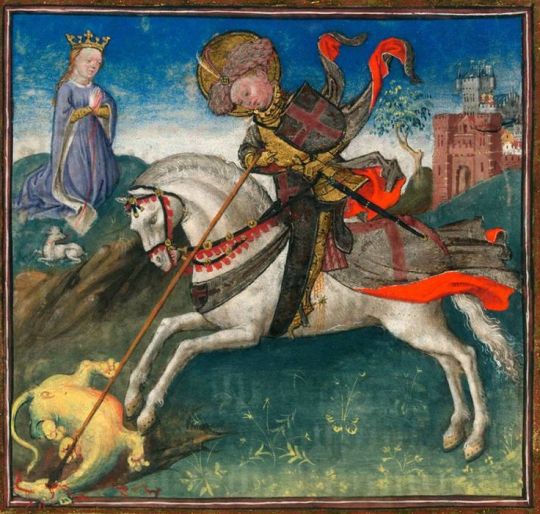
And this is the previous one, but now the baby dragon is cute. He's chubby. He's got toe beans. He's Puff the Magic Dragon. His eyes have already gone white, implying that George is just kicking its corpse around for funsies. What's the difference between the dragon and the lamb in the background? That the dragon is dead, like our innocence. This George is truly deserving of the dumbest hat of all. 0/10 plus one more butthole for the road
Horse thoughts: Perhaps it is we who are the buttholes.
#art history#nonsense#hot takes#I am doing a St. George painting and have been wading through reference material#manuscript#fuck me I didn't notice van der Weyden managed to sneak a butthole in his too#the definitive list#when knighthood was in flower
7K notes
·
View notes
Text
got a message out of the blue about that 'why Batman doesn't kill' explanation I left on someone else's post like two years ago but it was just "wait is Alfred dead????" and I sort of forgot that most of tumblr Batfam fandom doesn't actually read comics and so largely has no idea that Bane killed Alfred back in 2019 and he's stayed dead since
#kinda tragic really because it's been excellent angst material for Damian Dick and Jason (and Bruce of course)#even if it's also led to some absolutely baffling writing decisions (tom taylor. I'm looking directly at you)#Alfred's now the second-longest lasting death in batfam history next to Jason lmao#alfred pennyworth#bruce wayne#batman#batfam#EDIT: IF I SNEAKILY CORRECTED MY DATES SO I ACTUALLY NOTED THE CORRECT YEAR CITY OF BANE WAS PUBLISHED IN (2019): no I didn't.
1K notes
·
View notes
Text
Leonard Ogierman, 2017, “Phenomenon of Pro Patria Paper Expansion,” ŚLĄSKI KWARTALNIK NAUKOWY.
0 notes
Text
Early 18th (and late 17th) century fashions are so under-utilized in vampire media and I think it's a damn shame.
I don't actually think I've ever seen a single image of a vampire character in an early 18th century suit. Hardly any movies set in that era either, and hardly any historical costumers who do it.
(Even my beloved gay pirate show set in 1717 takes nearly all of its 18th century looks from the second half of the century. Not enough appreciation for baroque fashion!!)
Yes I love late 18th century fashion as much as anyone, and 19th century formal suits are all very well and good, but if you want something that says old, dead, wealthy, and slightly dishevelled, then the 1690's-1730's are where it's at.
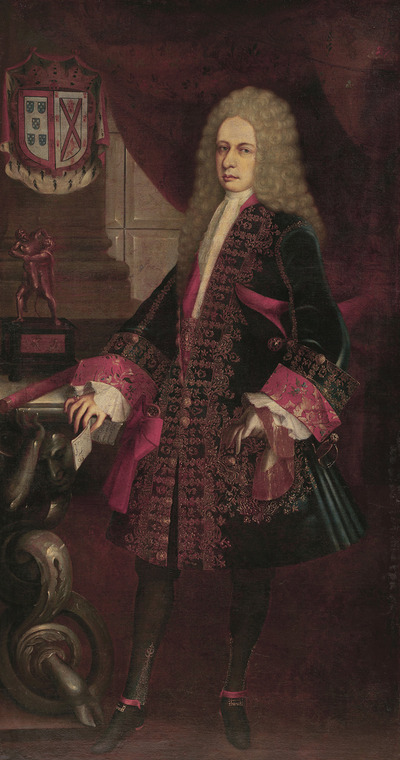
(Retrato del Virrey Alencastre Noroña y Silva, Duque de Linares, ca. 1711-1723.)
There was so much dark velvet, and so many little metallic buttons & buttonholes. Blood red linings were VERY fashionable in this era, no matter what the colour of the rest of the suit was.

(Johann Christoph Freiherr von Bartenstein by Martin van Meytens the Younger, 1730's.)
The slits on the front of the shirts are super low, they button only at the collar, and it's fashionable to leave most of the waistcoat unbuttoned so the shirt sticks out, as seen in the above portraits.

(Portrait of Anne Louis Goislard de Montsabert, Comte de Richbourg-le-Toureil, 1734.)
Waistcoats are very long, coats are very full, and the cuffs are huge. But the sleeves are on the shorter side to show off more of that shirt, and the ruffles if it has them! Creepy undead hands with long nails would sit so nicely under those ruffles.
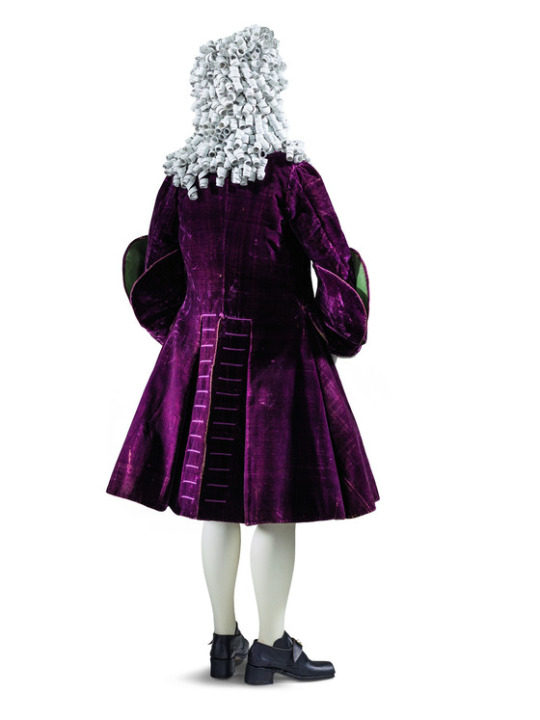
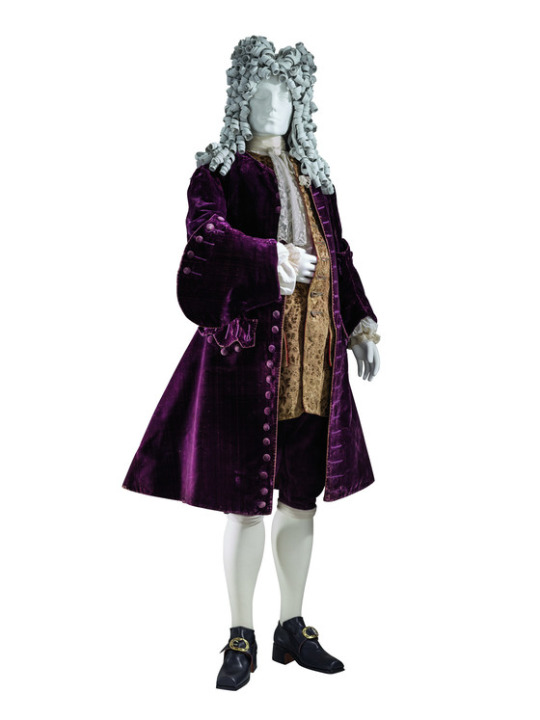
(1720's-30's, LACMA)
Embroidery designs are huge and chunky and often full of metallic threads, and the brocade designs even bigger.
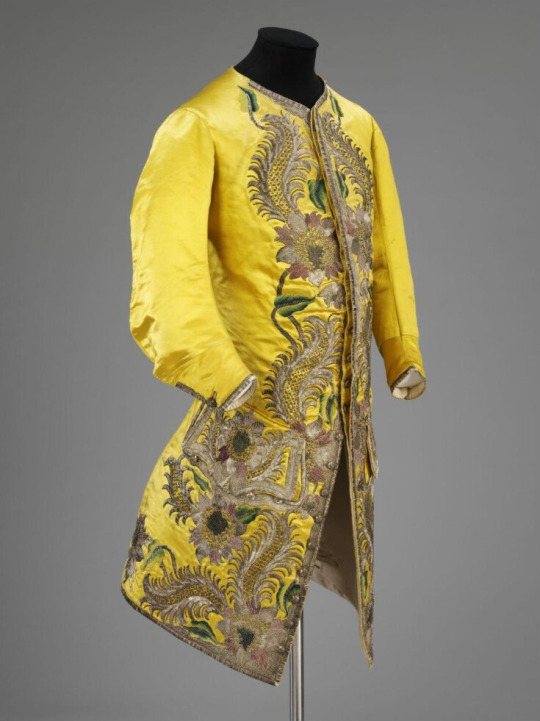
(1730's, V&A, metal and silk embroidery on silk satin.)
Sometimes they did this fun thing where the coat would have contrasting cuffs made from the same fabric as the waistcoat.
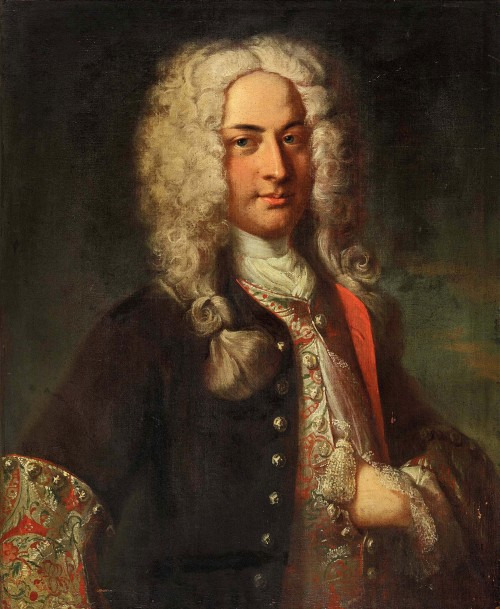
(Niklaus Sigmund Steiger by Johann Rudolf Huber, 1724.)
Tell me this look isn't positively made for vampires!
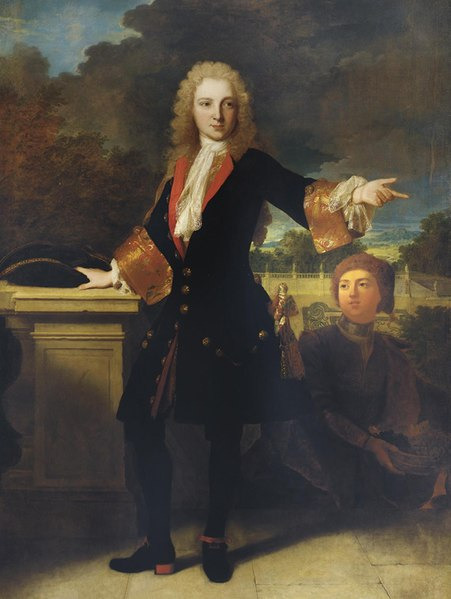
(Portrait of Jean-Baptiste de Roll-Montpellier, 1713.)
(Yeah I am cherry-picking mostly red and black examples for this post, and there are plenty of non-vampire-y looking images from this time, but you get the idea!)
And the wrappers (at-home robes) were also cut very large, and, if you could afford it, made with incredible brocades.
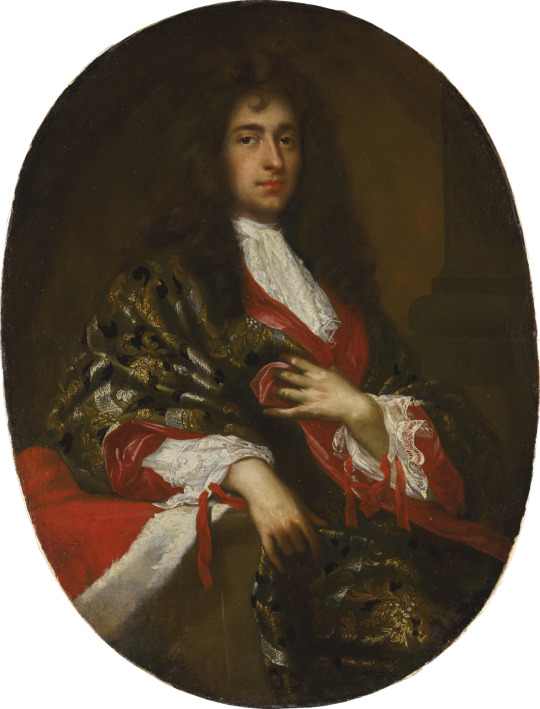
(Portrait of a nobleman by Giovanni Maria delle Piane, no date given but I'd guess maybe 1680's or 90's.)
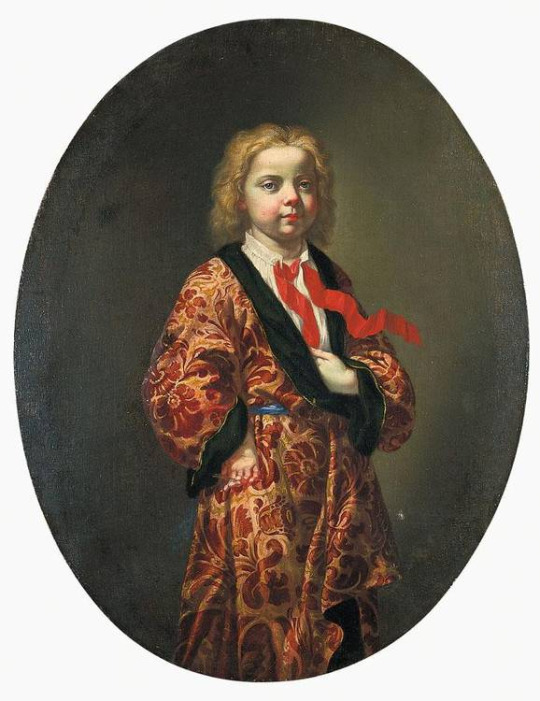
(Circle of Giovanni Maria delle Piane, no date given but I'd guess very late 17th or very early 18th century.)
Now that looks like a child who's been stuck at the same age for a hundred years if I ever saw one!
I don't know as much about the women's fashion from this era, but they had many equally large and elabourate things.

(1730's, Museo del Traje.)

(Don't believe The Met's shitty dating, this is a robe volante from probably the 1720's.)

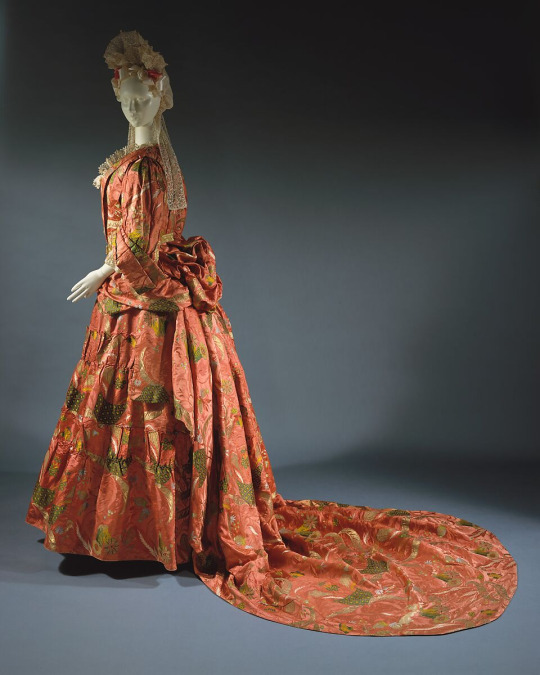
(Mantua, c. 1708, The Met. No idea why they had to be that specific when they get other things wrong by entire decades but ok.)

(Portrait of Duchess Colavit Piccolomini, 1690's.)

(Maria van Buttinga-van Berghuys by Hermannus Collenius, 1717.)
Sometimes they also had these cute little devil horn hair curls that came down on either side of the forehead.
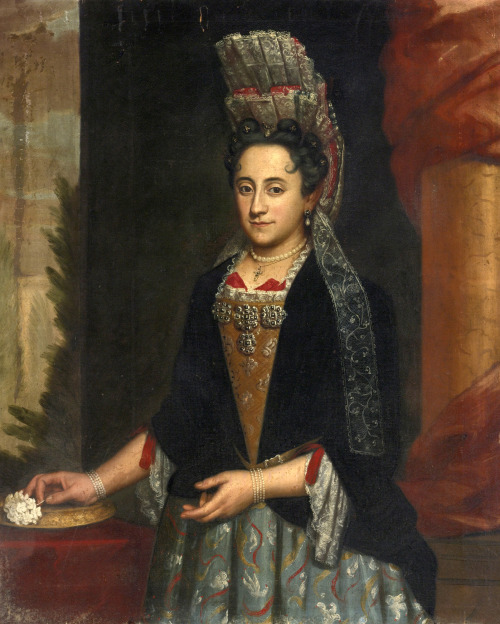
(Viago in drag Portrait of a lady, Italian School, c. 1690.)
Enough suave Victorian vampires, I want to see Baroque ones! With huge wigs and brocade coat cuffs so big they go past the elbow!
#long post#vampires#fashion#history#18th century#17th century#someday. SOMEDAY I will make a black/red/dark orange/metallic gold 1720's suit#I've got nearly all the materials I just need to:#1. Learn how to make early 18th century metallic thread buttons‚ preferably without having to buy the super expensive kind of thread#2. get a wig and style it appropriately
2K notes
·
View notes
Photo


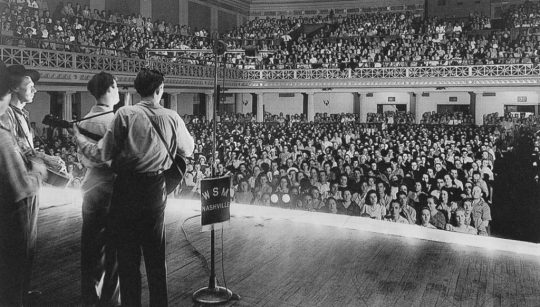

Lecture 1: Various artifacts from legendary clear channel radio station WSM Nashville and the Grand Ole Opry, the beloved Country Music variety show, 1920s-1940s. This was at the height of WSM’s popularity, when people were listening to the radio station from as far away as Los Angeles, Canada, and parts of Central and South America. The Grand Ole Opry had a huge influence on a number of early rock ‘n’ roll performers, including Chuck Berry, Elvis Presley, Carl Perkins, and Jerry Lee Lewis.
#Grand Ole Opry#WSM (radio station)#radio#Nashville#Country Music#Hillbilly Music#1920s#1930s#1940s#artifact#material history
0 notes
Text
saw someone argue that the central defining feature of fanfiction is its attention to proper characterisation. man I don’t think you’ve read very much fanfiction
#I think you end up with these idealistic arguments when you don’t define fanfiction#in relationship to intellectual property law. like that actually is its central defining characteristic & this definition doesn’t make any#claims about quality or content or style (or characterisation) because all of those are variable#so I’m being kind of mean here because I think the op was just trying to describe a relationship between fanfiction and the source material#without grounding it in history or law. so you end up with these silly normative claims about what goes on in fanfiction#anyway not going to link the post I’m referencing because the person was just being mildly annoying on a post of mine#and I was being nosy on their blog. I was just caught way off guard by that argument because like. lol#fandom discussion
642 notes
·
View notes
Text
im sure its been said already but as the election draws near more and more liberals will come out of the woodwork to shame people with a conscience to give away their vote to the democrats for free. i'm already seeing posts saying "why aren't people more concerned about a trump presidency?" you want to know why? it's because people already know he's bad. everyone already knows what he is and what he's done and what he'll do. there's nothing to discuss. he's a racist despotic worm of a man. there's nothing else to say.
biden is currently president. the genocide is happening under his watch. he's the one funding isra*l and arming them; he's sidestepped congress more than once to give them weapons. by oct. 27, the biden administration already knew that "Israel was regularly bombing buildings without solid intelligence that they were legitimate military targets." the state department/biden have engaged in atrocity propaganda, cast doubt on the legitimacy of the death toll recorded by the gaza health ministry, and so on. the united states is currently in the process of trying to pin the "war in gaza" on netanyahu (see sen. schumer's speech) after months of backing blatant genocide as a means to act as if they're "doing something" about the genocide (Instead of, say, threatening to cut off all aid to israel with the condition that all hostilities in gaza, the west bank, and occupied jerusalem are halted immediately and permanently, allowing palestinians freedom to travel, allowing aid into gaza, etc etc etc.)
the long and short of it is that liberals view their own lives as being worth more than palestinians'. that's it. they'll vote for another 4 years of the guy ushering in genocide and supporting apartheid + settler colonialism because he isn't outright attacking them (despite various laws and rulings happening both at the supreme court level and at the local level all over the country that will endanger people). they'll settle for the illusion of safety and security and shame anyone with a conscience and accuse them of "supporting the republicans" when in an actual democracy you would be able to use your vote as leverage to extract concessions from those who want to be elected. that's how it's supposed to fucking work.
democrats are not owed people's vote. if biden loses, it will be biden's fault; it will be his campaign's fault; it will be the democrats' fault. trump is bad; the republicans are bad. we already know this. this is not an endorsement of either. but if democrats are too cowardly and feckless and servile to the motivations of the american empire and never do anything for their constituents then why the fuck should anyone vote for them. you want to get mad at someone, why don't you do something useful and stop worrying about team-sports with a purely selfish basis and start hounding the people in power who are supposed to serve you, the voter.
#i think i already said this and frankly idc#uspol#📁.zip#to me personally it's abhorrent and vile to tell palestinians 'biden is facilitating the murder of your people culture and history but you#still have to vote for him!!1' like how is that not unbelievably callous and ghoulish#frankly speaking. a lot of this 'you should be concerned about trump' is going to turn into#blaming palestinians and arabs and muslims and anyone remotely with a conscience for biden's loss#instead of doing something productive like pushing for people in power to do something they'll nitpick and belittle#and tell palestinians + arabs and muslims + everyone who understands that genocide is bad that they SHOULD#settle for a decrepit genocidal monstrous freak who is CURRENTLY facilitating genocide because#it makes THEM feel better and they aren't personally threatened (yet) by the guy currently in power#any and all 'you're not taking trump seriously' comments should be met with extreme skepticism#because i promise i PROMISE that the vast majority of people unhappy with biden are not going to turn around and vote for trump#and if they do? well guess what THAT'S BIDEN'S FAULT! nevermind the vote uncommitted campaign that was very successful and#will be replicated in the near future. but liberals only care about asthetics and superficial and not#about real material change which is why they'll dress up their callousness and racism in a 'you hate gay people if you dont vote for biden'#like this country is already going to shit we are rapidly descending into fascism and i dont see biden doing anything to even remotely#challenge it do you???? once agian. NOT an endorsement of the republican party but my GOD when the 'lesser evil'#is DOING the evil or normalizing the evil then you cannot settle for 'the lesser'! end of story.
384 notes
·
View notes
Text


#tbh i do really think a lot of the problem here is that people chose to study *super kool radikewl politics* in college#instead of *boring dusty suuuuuuuper irrelevant* history#they don’t have the material to scaffold their theory on so they just make it the fuck up#politics#twitter
725 notes
·
View notes
Text
my pet peeve is those "historians thought they were very good friends" jokes, like obviously for sure there are homophobic historians, but the study of same-sex desire and relationships of the past is also quite complex and you can't often go and simply label people's relationships or identities of time gone by, and sometimes it's more complicated and elusive than "they were a couple" or even "they were in love"
#nor's rambles#being a bit of a queer theorist here#note also that historical research is interpreting source material and source material seldom is straightforward#different historians will likely come to different conclusions#i would also say!!! that i don't think a lot of people really know the history of labels and lgbtq+ knowledge#like lady gaga saying BORN THIS WAY can be liked all the way back to sexologists like havelock ellis saying that homosexuality is innate an#hence not a disease or a crime
552 notes
·
View notes
Quote
I always live in a dream world.
Jackie Kennedy in conversation with Richard Nixon, 1971
#jackie kennedy#history#this is absolutely devastating in context because they're discussing nostalgia and she's referring to her life without jack#this is what i hate about posting quotes on tumblr because they lose so much of their power outside of the source material#:/ oh well#'it doesn't matter now. let the coquette blogs come.' /beauty and the beast
707 notes
·
View notes
Text
immensely adore how much qsmp opens old wounds i love you oi queridinho i love you ‘i’m used to joining in the middle of wars’ i love you purgatory elytra i love you eggpire references i love you obsidian sleeping box i love you ‘i feel like in a past life we would have been enemies’ i love you
#eleanor.txt#qsmp#there’s definitely a lot more that i’m forgetting / aren’t as concise#cellbit saying he got foolish to build him a castle and he took credit for it and tubbo saying ‘i think i did that once’#each character has such a rich history and i eat UP self referential material#‘self’ referential. anyway i eat it UP every time
333 notes
·
View notes
Text
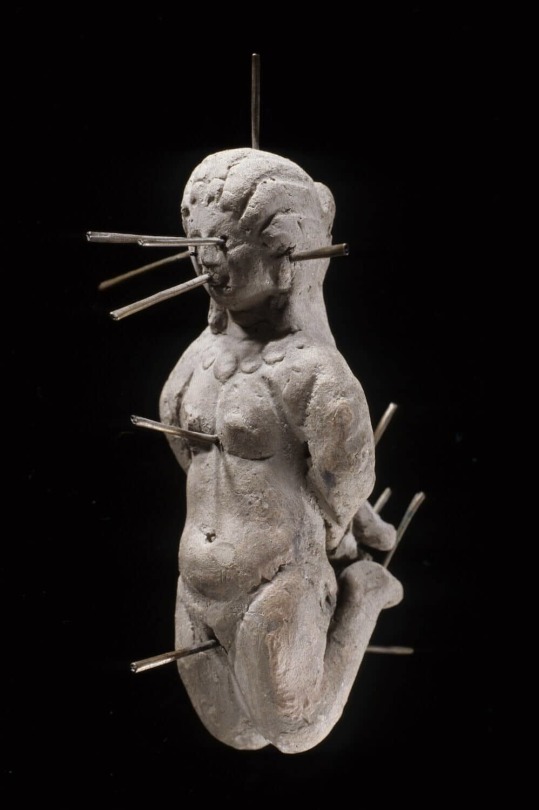

Greco-Roman curse doll
2nd century CE
#the word voodoo shouldn’t be thrown left and right like confetti by the way#let’s start calling things by their name#these are called kolossos (s.) kolossoi (p.)#equivalent of poppet. not necessarily used for harm#though in this specific case#and to use a definition in english#an object/s or material/s used to cast a curse#more specifically a love one - love curses are a thing#and curse doll should be just about right in English#there’s probably another dozen more accurate terms that still wouldn’t involve voodoo#this is called a testimone di fattura in Italian#translates to something like curse witness#ancient rome#greco roman#archeology#curse#hex#ancient curse#history#esoterica#esoterism#occult
784 notes
·
View notes
